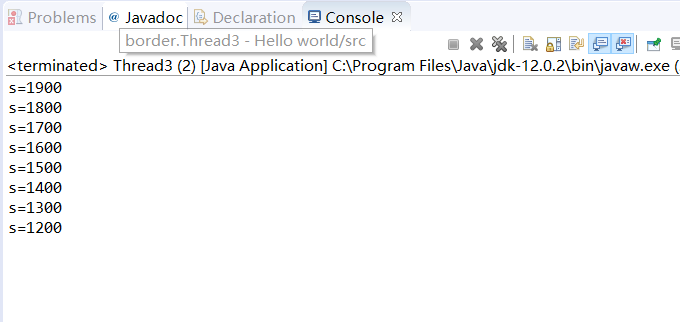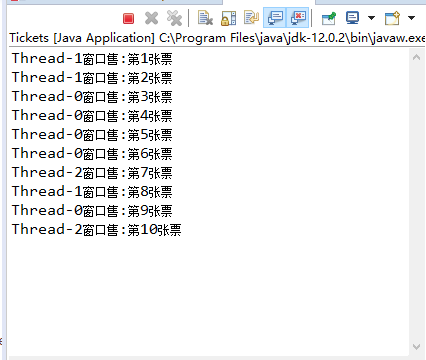201871010109-胡欢欢《面向对象程序设计(java)》第十七周学习总结
|
项目 |
内容 |
|
这个作业属于哪个课程 |
https://www.cnblogs.com/nwnu-daizh/ |
|
这个作业的要求在哪里 |
https://www.cnblogs.com/nwnu-daizh/p/11435127.html |
|
作业学习目标 |
1) 理解和掌握线程的优先级属性及调度方法; (2) 掌握线程同步的概念及实现技术; (3) Java线程综合编程练习 |
第一部分:总结线程同步技术
当我们使用多个线程访问同一资源的时候,且多个线程中对资源有写的操作,就容易出现线程安全问题。
要解决上述多线程并发访问一个资源的安全性问题:也就是解决重复票与不存在票问题,Java中提供了同步机制
(synchronized)来解决。
根据案例简述:
窗口1线程进入操作的时候,窗口2和窗口3线程只能在外等着,窗口1操作结束,窗口1和窗口2和窗口3才有机会进入代码
去执行。也就是说在某个线程修改共享资源的时候,其他线程不能修改该资源,等待修改完毕同步之后,才能去抢夺CPU
资源,完成对应的操作,保证了数据的同步性,解决了线程不安全的现象。
有三种方式完成同步操作:
1. 同步代码块。
2. 同步方法。
3. 锁机制。
同步代码块:
synchronized 关键字可以用于方法中的某个区块中,表示只对这个区块的资源实行互斥访问。
格式:
同步锁:
对象的同步锁只是一个概念,可以想象为在对象上标记了一个锁.
1. 锁对象 可以是任意类型。
2. 多个线程对象 要使用同一把锁。
注意:在任何时候,最多允许一个线程拥有同步锁,谁拿到锁就进入代码块,其他的线程只能在外等着
(BLOCKED)。
public class Ticket implements Runnable{ private int ticket = 100; Object lock = new Object(); /* * 执行卖票操作 */ @Override public void run() { //每个窗口卖票的操作 //窗口 永远开启 while(true){ synchronized (lock) { if(ticket>0){//有票 可以卖 //出票操作 //使用sleep模拟一下出票时间 try { Thread.sleep(50); } catch (InterruptedException e) { // TODO Auto‐generated catch block e.printStackTrace(); } //获取当前线程对象的名字 String name = Thread.currentThread().getName(); System.out.println(name+"正在卖:"+ticket‐‐); } } }
同步方法:使用synchronized修饰的方法,就叫做同步方法,保证A线程执行该方法的时候,其他线程只能在方法外
等着。
格式:
同步锁是谁?
对于非static方法,同步锁就是this。
对于static方法,我们使用当前方法所在类的字节码对象(类名.class)。
public class Ticket implements Runnable{ private int ticket = 100; /* * 执行卖票操作 */ @Override public void run() { //每个窗口卖票的操作 //窗口 永远开启 while(true){ sellTicket(); } } /* * 锁对象 是 谁调用这个方法 就是谁 * 隐含 锁对象 就是 this * */ public synchronized void sellTicket(){ if(ticket>0){//有票 可以卖 //出票操作 //使用sleep模拟一下出票时间 try { Thread.sleep(100); } catch (InterruptedException e) { // TODO Auto‐generated catch block e.printStackTrace();
Lock锁
java.util.concurrent.locks.Lock 机制提供了比synchronized代码块和synchronized方法更广泛的锁定操作,
同步代码块/同步方法具有的功能Lock都有,除此之外更强大,更体现面向对象。
Lock锁也称同步锁,加锁与释放锁方法化了,如下:
public void lock() :加同步锁。
public void unlock() :释放同步锁。
public class Ticket implements Runnable{ private int ticket = 100; Lock lock = new ReentrantLock(); /* * 执行卖票操作 */ @Override public void run() { //每个窗口卖票的操作 //窗口 永远开启 while(true){ lock.lock(); if(ticket>0){//有票 可以卖 //出票操作 //使用sleep模拟一下出票时间 try { Thread.sleep(50); } catch (InterruptedException e) { // TODO Auto‐generated catch block e.printStackTrace(); } //获取当前线程对象的名字 String name = Thread.currentThread().getName(); System.out.println(name+"正在卖:"+ticket‐‐); } lock.unlock(); } } }
第二部分:实验部分
1、实验目的与要求
(1) 掌握线程同步的概念及实现技术;
(2) 线程综合编程练习
2、实验内容和步骤
实验1:测试程序并进行代码注释。
测试程序1:
l 在Elipse环境下调试教材651页程序14-7,结合程序运行结果理解程序;
l 掌握利用锁对象和条件对象实现的多线程同步技术。
package 线程; /** * This program shows how multiple threads can safely access a data structure. * @version 1.31 2015-06-21 * @author Cay Horstmann */ public class SynchBankTest { public static final int NACCOUNTS = 100; public static final double INITIAL_BALANCE = 1000; public static final double MAX_AMOUNT = 1000; public static final int DELAY = 10; public static void main(String[] args) { Bank bank = new Bank(NACCOUNTS, INITIAL_BALANCE);//创建银行类 for (int i = 0; i < NACCOUNTS; i++) { int fromAccount = i; //Runnable类创建多线程 Runnable r = () -> { try { while (true) { int toAccount = (int) (bank.size() * Math.random()); double amount = MAX_AMOUNT * Math.random(); bank.transfer(fromAccount, toAccount, amount); Thread.sleep((int) (DELAY * Math.random())); } } catch (InterruptedException e) { } }; Thread t = new Thread(r);//实现Thread类 t.start(); } } }
package synch; import java.util.*; import java.util.concurrent.locks.*; /** * A bank with a number of bank accounts that uses locks for serializing access. * @version 1.30 2004-08-01 * @author Cay Horstmann */ public class Bank { private final double[] accounts;//创建一个账户数组 private Lock bankLock; private Condition sufficientFunds; /** * Constructs the bank. /* * @param n the number of accounts * @param initialBalance the initial balance for each account */ public Bank(int n, double initialBalance)//创建构造方法bank { accounts = new double[n]; Arrays.fill(accounts, initialBalance); bankLock = new ReentrantLock();//创建一个ReentrankLock对象,名为bankLock sufficientFunds = bankLock.newCondition();//调用newCondition方法获得一个条件对象 } /** * Transfers money from one account to another. * @param from the account to transfer from * @param to the account to transfer to * @param amount the amount to transfer */ public void transfer(int from, int to, double amount) throws InterruptedException //创建转账的方法 { bankLock.lock();//获取一个锁,如果锁同时被另一个线程拥有则发生阻塞 try { while (accounts[from] < amount)//判断账户余额是否少于要转账的金额 sufficientFunds.await();//让线程进入阻塞状态 System.out.print(Thread.currentThread()); accounts[from] -= amount;//进行转账操作 System.out.printf(" %10.2f from %d to %d", amount, from, to); accounts[to] += amount; System.out.printf(" Total Balance: %10.2f%n", getTotalBalance()); sufficientFunds.signalAll();//解除等待线程的阻塞 } finally { bankLock.unlock(); } } /** * Gets the sum of all account balances. * @return the total balance */ public double getTotalBalance() { bankLock.lock(); try { double sum = 0; for (double a : accounts) sum += a; return sum; } finally { bankLock.unlock(); } } /** * Gets the number of accounts in the bank. * @return the number of accounts */ public int size() { return accounts.length; } }
测试程序2:
l 在Elipse环境下调试教材655页程序14-8,结合程序运行结果理解程序;
l 掌握synchronized在多线程同步中的应用。
package synch2; /** * This program shows how multiple threads can safely access a data structure, * using synchronized methods. * @version 1.31 2015-06-21 * @author Cay Horstmann */ public class SynchBankTest2 { public static final int NACCOUNTS = 100; public static final double INITIAL_BALANCE = 1000; public static final double MAX_AMOUNT = 1000; public static final int DELAY = 10; public static void main(String[] args) { Bank bank = new Bank(NACCOUNTS, INITIAL_BALANCE); for (int i = 0; i < NACCOUNTS; i++) { int fromAccount = i; Runnable r = () -> { try { while (true) { int toAccount = (int) (bank.size() * Math.random()); double amount = MAX_AMOUNT * Math.random(); bank.transfer(fromAccount, toAccount, amount); Thread.sleep((int) (DELAY * Math.random())); } } catch (InterruptedException e) { } }; Thread t = new Thread(r); t.start(); } } }
package 线程; import java.util.*; /** * A bank with a number of bank accounts that uses synchronization primitives. * @version 1.30 2004-08-01 * @author Cay Horstmann */ public class Bank { private final double[] accounts;//创建一个数组类型的账户 /** * Constructs the bank. * @param n the number of accounts * @param initialBalance the initial balance for each account */ public Bank(int n, double initialBalance)//创建构造方法bank { accounts = new double[n]; Arrays.fill(accounts, initialBalance);//初始平衡每个帐户的初始余额 } /** * Transfers money from one account to another. * @param from the account to transfer from * @param to the account to transfer to * @param amount the amount to transfer */ public synchronized void transfer(int from, int to, double amount) throws InterruptedException //使用synchronsized修饰的方法,使其为同步方法 { while (accounts[from] < amount)//判断账户余额是否少于要转账的金额 wait();//如果是让该线程进入wait方法,线程的阻塞 System.out.print(Thread.currentThread()); accounts[from] -= amount;//进行转账操作 System.out.printf(" %10.2f from %d to %d", amount, from, to); accounts[to] += amount; System.out.printf(" Total Balance: %10.2f%n", getTotalBalance()); notifyAll();//接触那些在 对象上调用wait方法的线程阻塞状态 } /** * Gets the sum of all account balances. * @return the total balance */ public synchronized double getTotalBalance()//synchronized所修饰的方法 { double sum = 0; for (double a : accounts)//对账户进行遍历,得到账户是总额 sum += a; return sum; } /** * Gets the number of accounts in the bank. * @return the number of accounts */ public int size() { return accounts.length; } }
测试程序3:
l 在Elipse环境下运行以下程序,结合程序运行结果分析程序存在问题;
l 尝试解决程序中存在问题。
class Cbank { private static int s=2000; public static void sub(int m) { int temp=s; temp=temp-m; try { Thread.sleep((int)(1000*Math.random())); } catch (InterruptedException e) { } s=temp; System.out.println("s="+s); } } class Customer extends Thread { public void run() { for( int i=1; i<=4; i++) Cbank.sub(100); } } public class Thread3 { public static void main(String args[]) { Customer customer1 = new Customer(); Customer customer2 = new Customer(); customer1.start(); customer2.start(); } }
问题:由于多个线程同时进行执行,影响线程安全
解决代码:
package 线程; import java.util.concurrent.locks.Lock; import java.util.concurrent.locks.ReentrantLock; public class Cbank { static Lock lock=new ReentrantLock(); private static int s = 2000; public static void sub(int m) { lock.lock(); int temp = s; temp = temp - m; try { Thread.sleep((int) (1000 * Math.random())); } catch (InterruptedException e) { } s = temp; System.out.println("s=" + s); lock.unlock(); } }
package 图像程序设计; import 线程.Customer; public class Thread3 { public static void main(String[] args) { { Customer customer1 = new Customer(); Customer customer2 = new Customer(); customer1.start(); customer2.start(); } } }
package 线程; import java.util.concurrent.locks.Lock; import java.util.concurrent.locks.ReentrantLock; public class Customer extends Thread { // Object lock = new Object(); // Lock lock=new ReentrantLock(); public void run() { //synchronized (lock) { for (int i = 1; i <= 4; i++) { Cbank cbank = new Cbank(); cbank.sub(100); //} } } }
第二种:
package border; class Cbank { private static int s=2000; public static synchronized void sub(int m) { int temp=s; temp=temp-m; try { Thread.sleep((int)(1000*Math.random())); } catch (InterruptedException e) { } s=temp; System.out.println("s="+s); } } class Customer extends Thread { public void run() { for( int i=1; i<=4; i++) Cbank.sub(100); } } public class Thread3 { public static void main(String args[]) { Customer customer1 = new Customer(); Customer customer2 = new Customer(); customer1.start(); customer2.start(); } }
运行截图:

实验2 编程练习
利用多线程及同步方法,编写一个程序模拟火车票售票系统,共3个窗口,卖10张票,程序输出结果类似(程序输出不唯一,可以是其他类似结果)。
Thread-0窗口售:第1张票
Thread-0窗口售:第2张票
Thread-1窗口售:第3张票
Thread-2窗口售:第4张票
Thread-2窗口售:第5张票
Thread-1窗口售:第6张票
Thread-0窗口售:第7张票
Thread-2窗口售:第8张票
Thread-1窗口售:第9张票
Thread-0窗口售:第10张票
编程代码:
package sy; public class Tickets { public static void main(String[] args) { Ticket ticket=new Ticket(); Thread t1= new Thread(ticket,"Thread-0"); Thread t2 = new Thread(ticket,"Thread-1"); Thread t3 = new Thread(ticket,"Thread-2"); t1.start(); t2.start(); t3.start(); } }
package sy; import java.util.concurrent.locks.Lock; import java.util.concurrent.locks.ReentrantLock; public class Ticket implements Runnable { private int ticket =1; Lock lock = new ReentrantLock(); @Override public void run() { // TODO Auto-generated method stub while (true) { // 每个窗口永远开启 lock.lock(); if (ticket <=10) { try { Thread.sleep(50); } catch (InterruptedException e) { e.printStackTrace(); } // 获得当前线程对象名字 String name = Thread.currentThread().getName(); System.out.println(name + "窗口售:第" + ticket+++"张票"); } lock.unlock(); } } }

第三部分:实验总结
通过本次实验我对线程的理解得以加深,并且学习到了线程常见问题的解决方法,在今后我会继续努力。

